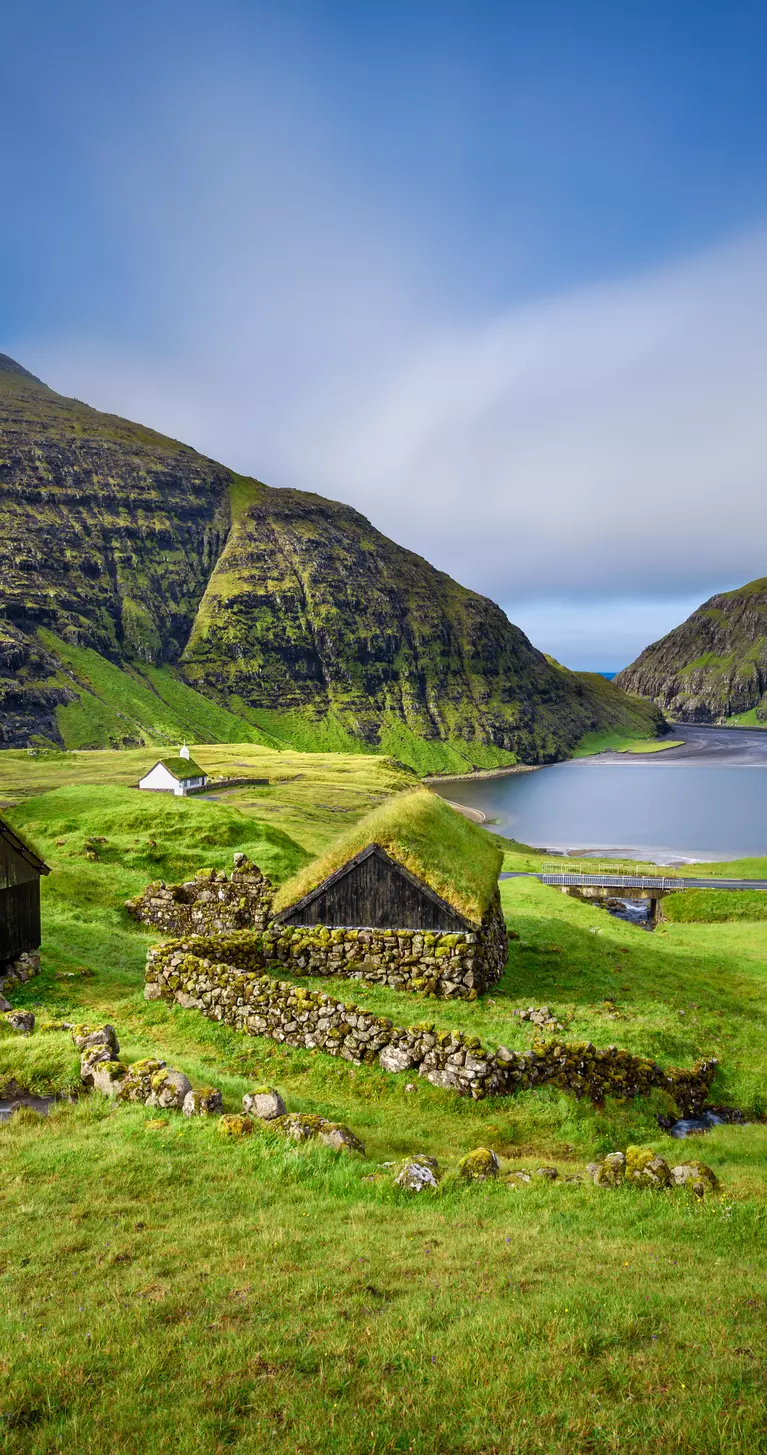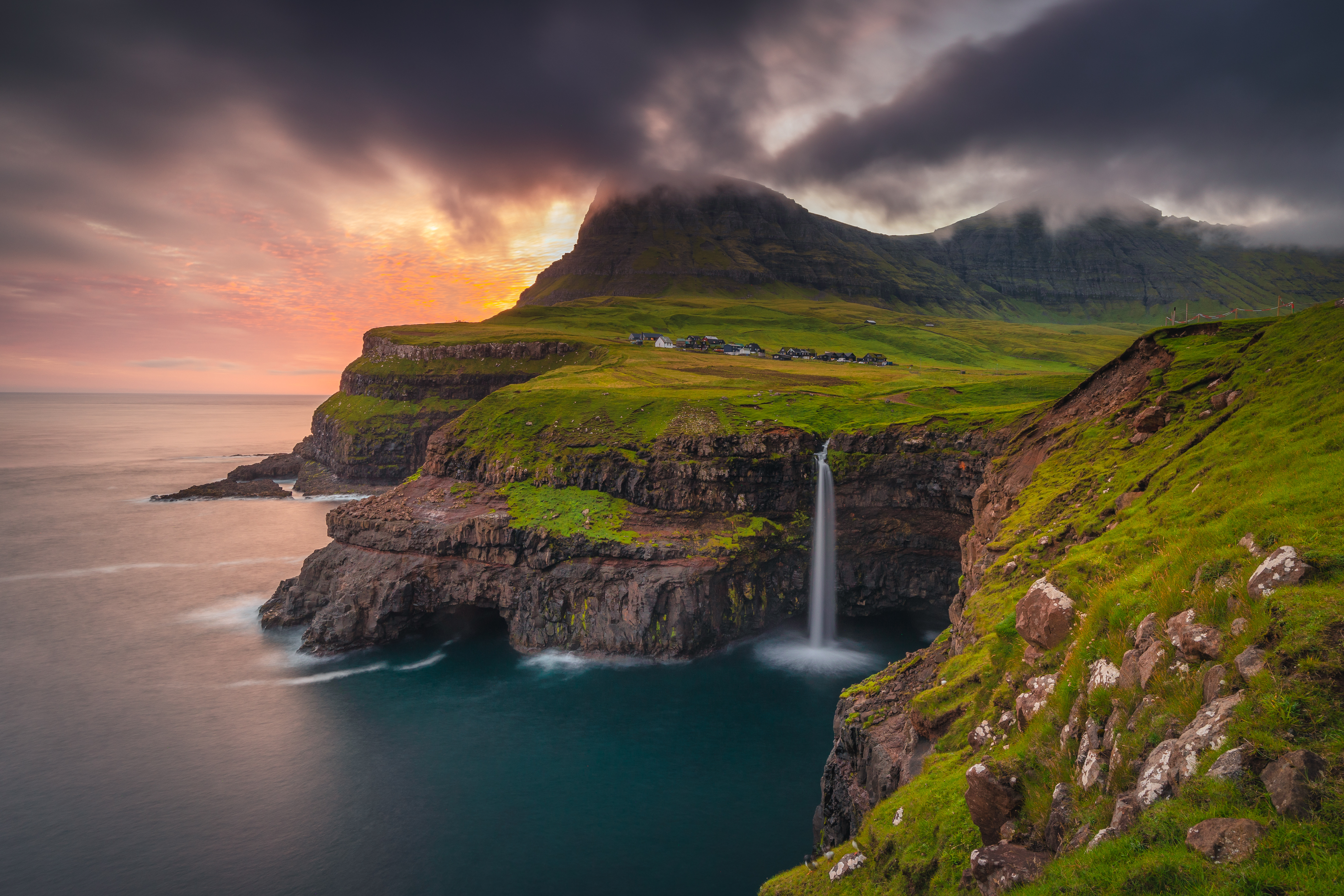US and Canadian citizens do not need a visa for short visits of up to 90 days, as entry is covered under Denmark’s visa rules (though the Faroes are not part of the Schengen Zone). You’ll need a passport valid for at least three months beyond your stay. No special permits are required for general travel, though some private hiking areas may charge access fees.
Discover Tailor-Made Faroe Islands Vacations
Remote Nordic beauty where dramatic cliffs, fjords, and bird-filled skies await curious travellers.
Discover the Faroe Islands, an untouched North Atlantic archipelago of green valleys, rugged coastlines, and historic villages. Explore fishing hamlets, hike mountain trails, and witness seabird colonies soaring above dramatic sea cliffs. A journey here feels both wild and deeply cultural.
Featured Highlights
- Dramatic cliffs alive with puffins, gannets, and seabird colonies
- Hiking trails with sweeping views across fjords and valleys
- Tórshavn’s grass-roofed houses and small but vibrant harbour
- Fishing villages where traditions remain part of daily life
- Ferry rides linking 18 volcanic islands across the sea
- Waterfalls tumbling straight into the North Atlantic
Featured Faroe Islands Trip Ideas
A North Atlantic adventure shaped by cliffs, fjords, and timeless traditions.Journey through the Faroe Islands’ raw beauty, where windswept landscapes meet centuries-old traditions. The 18 volcanic islands are linked by bridges, tunnels, and ferries, making exploration seamless. Wander through Tórshavn, one of the world’s smallest capitals, with its grass-roofed houses and lively harbour. Follow winding roads past cascading waterfalls and green valleys leading to dramatic viewpoints. Birdwatchers will marvel at puffins and gannets nesting on towering cliffs, while hikers can trek along remote paths that reveal unforgettable vistas. The Faroes blend Nordic culture with a strong sense of independence, offering travellers a chance to slow down and experience nature’s rhythm at its purest.
Faroe Islands Classic Circle Road Trip
TorshavnEssential North to South Faroe Islands by Car
TorshavnEssential Faroe Islands
TorshavnFaroe Islands for Foodies
TorshavnDon't see the
perfect trip idea?
Request a custom quote.
Turn your travel dreams into reality with Goway. Our customized vacations take travellers to all corners of the world.
What do Goway's travellers say?

Get to know Faroe Islands before you go.
Best Time to Visit
The Faroe Islands are a land of shifting skies, where sunshine, mist and rain weave together in quick succession. Caught between the Gulf Stream and the North Atlantic, the islands’ weather is famously unpredictable, so packing both a warm jacket and a raincoat is wise for any journey.
Summer, from June to August, is when the islands truly come alive. With nearly 22 hours of daylight, it is the perfect time to hike dramatic cliffs, watch puffins nesting, or glide across fjords by kayak. The mild weather makes exploring coastal villages and rolling green landscapes especially rewarding.
By September, autumn brings cooler air and more rainfall, along with an atmosphere many travellers find quietly enchanting. It is also a promising time to see the Northern Lights, though winter offers the best displays. With fewer crowds, accommodation is easier to find, and tours continue for those seeking a more intimate experience of the islands.
Winter transforms the Faroes into a place of hushed beauty. Snow may fall, though not always, blanketing villages and mountains in soft white. Days are short, but the Northern Lights often dance above on clear nights. While some attractions close, the peace and stillness of winter travel here reveal another side of these wild and wonderful islands.
Travel Styles
Explore Faroe Islands by Travel Type
Ways to Travel
Discover your perfect travel style—crafted for every dream and journey.

Themes
Immersive adventures shaped by passion, such as food, culture, wellness, and wild discovery.

Ways to Travel
Discover your perfect travel style—crafted for every dream and journey.

Themes
Immersive adventures shaped by passion, such as food, culture, wellness, and wild discovery.
Frequently Asked Questions
Do I need a visa or special permits to enter the Faroe Islands?
What language is spoken locally? How widely is English understood in the Faroe Islands?
Faroese is the official language, with Danish also widely used. English is commonly spoken, especially in hotels, restaurants, and among younger locals, so travellers generally find communication easy.
What are the must-see attractions in the Faroe Islands?
The dramatic landscapes are the star. Sørvágsvatn, the “lake above the ocean,” creates an optical illusion where water seems suspended over cliffs. The village of Gásadalur, framed by the Múlafossur waterfall plunging into the sea, is iconic. Tórshavn, the capital, has a charming old town with turf-roofed houses. Mykines Island is a paradise for puffin watching in summer. Hiking trails across mountains and fjords reveal remote, postcard-like villages.
Is the Faroe Islands safe? What should I keep in mind while travelling there?
The Faroe Islands are extremely safe, with very low crime. The main risks are weather-related—conditions change quickly, with fog, wind, and rain common. If hiking, check forecasts, dress in layers, and follow marked routes. Sheep and narrow roads also require caution when driving.
What's the best way to travel within the Faroe Islands?
Renting a car is the easiest way to explore, as public transport is limited in rural areas. Subsea tunnels, ferries, and bridges link most islands. Local buses and ferries are reliable for some routes, but schedules can be infrequent. Helicopter services are available and surprisingly affordable, though primarily used by locals.
What Faroese cultural customs should I be aware of?
The Faroese are warm but reserved. A polite greeting and handshake are appreciated. Respect nature and private land—some hikes cross grazing areas where small fees or permission are expected. Dining out is relaxed, and tipping is not expected, though rounding up the bill is a kind gesture.
What should I wear/pack for the Faroe Islands' climate?
The climate is cool, damp, and unpredictable year-round. Pack warm layers, a waterproof jacket, and sturdy hiking boots. Even in summer, temperatures are mild, so bring sweaters and a hat. Gloves and a scarf can be useful in windy conditions. A camera with weather protection is worthwhile for capturing the dramatic scenery.
Unlock more by subscribing to our newsletter
With our newsletter, you’ll get access to regular communications that inspire you and help you explore the world your way



